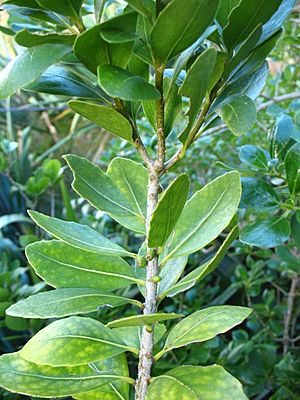Coastal mahoe facts for kids
Quick facts for kids Coastal mahoe |
|
|---|---|
 |
|
| Scientific classification | |
| Genus: |
Melicytus
|
| Species: |
novae-zelandiae
|
The coastal mahoe (scientific name: Melicytus novae-zelandiae) is a special flowering plant. It belongs to the violet family. This plant mostly grows along the coast of New Zealand. You can find it from the Bay of Plenty area and further north. It especially likes to grow on islands near the coast.
While most coastal mahoe plants are found in New Zealand, one type also lives on Lord Howe Island in Australia. The second part of its scientific name, novae-zelandiae, means "of New Zealand." This name tells us where it mainly comes from.
What is Coastal Mahoe?
The coastal mahoe is a small shrub. It has many stems and can grow up to 2 meters (about 6.5 feet) tall. It is a "dioecious" plant. This means some plants have only male flowers, and other plants have only female flowers.
Flowers and Berries
This plant produces small, bell-shaped flowers. They are a yellowish-green color. You can usually see these flowers in August and September.
Later, from late August to October, the plant grows berries. These berries are white with purple spots. They add a splash of color to the plant.
Different Types of Coastal Mahoe
Scientists sometimes divide plants into smaller groups called subspecies. These are like different versions of the same plant.
There are two main subspecies of coastal mahoe:
- Melicytus novae-zelandiae subsp. novae-zelandiae: This is the type found in New Zealand.
- Melicytus novae-zelandiae subsp. centurionis: This type is special because it only grows on Lord Howe Island in Australia.

